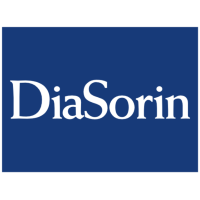
DiaSorin SpA
MIL:DIA


| US |

|
Johnson & Johnson
NYSE:JNJ
|
Pharmaceuticals
|
| US |

|
Berkshire Hathaway Inc
NYSE:BRK.A
|
Financial Services
|
| US |

|
Bank of America Corp
NYSE:BAC
|
Banking
|
| US |

|
Mastercard Inc
NYSE:MA
|
Technology
|
| US |

|
UnitedHealth Group Inc
NYSE:UNH
|
Health Care
|
| US |

|
Exxon Mobil Corp
NYSE:XOM
|
Energy
|
| US |

|
Pfizer Inc
NYSE:PFE
|
Pharmaceuticals
|
| US |

|
Palantir Technologies Inc
NYSE:PLTR
|
Technology
|
| US |

|
Nike Inc
NYSE:NKE
|
Textiles, Apparel & Luxury Goods
|
| US |

|
Visa Inc
NYSE:V
|
Technology
|
| CN |

|
Alibaba Group Holding Ltd
NYSE:BABA
|
Retail
|
| US |

|
3M Co
NYSE:MMM
|
Industrial Conglomerates
|
| US |

|
JPMorgan Chase & Co
NYSE:JPM
|
Banking
|
| US |

|
Coca-Cola Co
NYSE:KO
|
Beverages
|
| US |

|
Walmart Inc
NYSE:WMT
|
Retail
|
| US |

|
Verizon Communications Inc
NYSE:VZ
|
Telecommunication
|
Utilize notes to systematically review your investment decisions. By reflecting on past outcomes, you can discern effective strategies and identify those that underperformed. This continuous feedback loop enables you to adapt and refine your approach, optimizing for future success.
Each note serves as a learning point, offering insights into your decision-making processes. Over time, you'll accumulate a personalized database of knowledge, enhancing your ability to make informed decisions quickly and effectively.
With a comprehensive record of your investment history at your fingertips, you can compare current opportunities against past experiences. This not only bolsters your confidence but also ensures that each decision is grounded in a well-documented rationale.
Do you really want to delete this note?
This action cannot be undone.

| 52 Week Range |
83.3
110.5
|
| Price Target |
|
We'll email you a reminder when the closing price reaches EUR.
Choose the stock you wish to monitor with a price alert.

|
Johnson & Johnson
NYSE:JNJ
|
US |

|
Berkshire Hathaway Inc
NYSE:BRK.A
|
US |

|
Bank of America Corp
NYSE:BAC
|
US |

|
Mastercard Inc
NYSE:MA
|
US |

|
UnitedHealth Group Inc
NYSE:UNH
|
US |

|
Exxon Mobil Corp
NYSE:XOM
|
US |

|
Pfizer Inc
NYSE:PFE
|
US |

|
Palantir Technologies Inc
NYSE:PLTR
|
US |

|
Nike Inc
NYSE:NKE
|
US |

|
Visa Inc
NYSE:V
|
US |

|
Alibaba Group Holding Ltd
NYSE:BABA
|
CN |

|
3M Co
NYSE:MMM
|
US |

|
JPMorgan Chase & Co
NYSE:JPM
|
US |

|
Coca-Cola Co
NYSE:KO
|
US |

|
Walmart Inc
NYSE:WMT
|
US |

|
Verizon Communications Inc
NYSE:VZ
|
US |
This alert will be permanently deleted.
 DiaSorin SpA
DiaSorin SpA
DiaSorin SpA
Investor Relations
In the heart of the global healthcare landscape, DiaSorin SpA stands as a testament to innovation and precision in the field of biotechnology. Founded in 1968 in Italy, the company built its reputation on developing and producing diagnostic tests that help identify and monitor diseases. With a primary focus on immunodiagnostic and molecular diagnostic products, DiaSorin excels in creating high-quality, reliable solutions that clinicians and labs around the world depend on. Their product portfolio ranges widely, covering infectious diseases, oncology, endocrinology, and more. By leveraging cutting-edge research and development processes, DiaSorin not only prioritizes accuracy and efficiency in its testing solutions but also adapts to the ever-evolving demands of the medical world, cementing its role as a leader in diagnostic innovation.
From a business perspective, DiaSorin's revenue streams are deeply intertwined with its prowess in developing proprietary testing technologies, including both instruments and consumables. The company operates with a dual-channel business model where it sells diagnostic machines to laboratories, hospitals, and clinics while simultaneously providing the reagents and kits necessary for these machines' continuous operation. This approach ensures not only a sale of sophisticated equipment but also a recurring revenue stream from the consumables needed for diagnostics. With a strategic emphasis on research and partnerships, DiaSorin has expanded its reach globally, ensuring its products meet diverse regional healthcare requirements. Through a combination of robust product offerings and strategic global expansion, DiaSorin continues to thrive and maintain its position as a pivotal contributor to the field of diagnostic medicine.

In the heart of the global healthcare landscape, DiaSorin SpA stands as a testament to innovation and precision in the field of biotechnology. Founded in 1968 in Italy, the company built its reputation on developing and producing diagnostic tests that help identify and monitor diseases. With a primary focus on immunodiagnostic and molecular diagnostic products, DiaSorin excels in creating high-quality, reliable solutions that clinicians and labs around the world depend on. Their product portfolio ranges widely, covering infectious diseases, oncology, endocrinology, and more. By leveraging cutting-edge research and development processes, DiaSorin not only prioritizes accuracy and efficiency in its testing solutions but also adapts to the ever-evolving demands of the medical world, cementing its role as a leader in diagnostic innovation.
From a business perspective, DiaSorin's revenue streams are deeply intertwined with its prowess in developing proprietary testing technologies, including both instruments and consumables. The company operates with a dual-channel business model where it sells diagnostic machines to laboratories, hospitals, and clinics while simultaneously providing the reagents and kits necessary for these machines' continuous operation. This approach ensures not only a sale of sophisticated equipment but also a recurring revenue stream from the consumables needed for diagnostics. With a strategic emphasis on research and partnerships, DiaSorin has expanded its reach globally, ensuring its products meet diverse regional healthcare requirements. Through a combination of robust product offerings and strategic global expansion, DiaSorin continues to thrive and maintain its position as a pivotal contributor to the field of diagnostic medicine.





























 You don't have any saved screeners yet
You don't have any saved screeners yet
